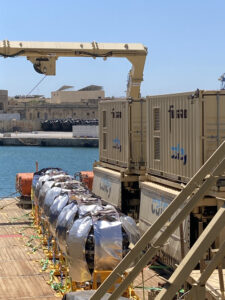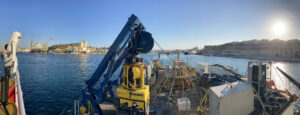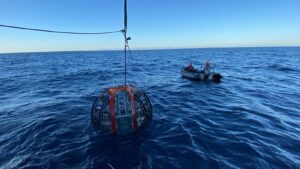Major upgrade of ARCA’s seafloor network
22 November 2022 – After 4 years of activities carried out by the Italian funding agency INFN and Alcatel Submarine Networks, part of Nokia, the new subsea network for KM3NeT ARCA, funded under the Idmar regional project in Italy, is now complete.
The new system comprises a 100 km long electro-optical cable, equipped with 48 optical fibres for detector control and data communication and two electrical conductors for power distribution, connected to the shore station control and power feeding equipment, that can deliver up to 80 kW offshore. The cable is bifurcated in order to serve the two building blocks foreseen in ARCA.
During a 10 days long sea operation, which ended on November 17th, a cable termination frame (CTF) was installed on the northern branch of the cable. To this purpose the end of the cable, which was deployed already in 2020, was recovered from the sea floor and connected to the CTF onboard the deployment ship – the Ile d’Ouessant of Alcatel Submarine Networks. Then the CTF was carefully deployed to the target position on the sea floor. Extensive tests were done before and after the deployment to ensure its nominal behaviour.
The CTF is a large-size, 12-ton component which is equipped with four medium voltage converters and a total of 16 electrical and optical subsea connectors for connecting a set of submarine junction boxes to which the detection units will be in turn connected.
With this installation the connectivity and power transmission capabilities of the network have been increased by a factor four compared to the first part of the network, used to run the set of junction boxes and the first 30 detection units of ARCA Phase 1. This will allow for the completion of the construction of the first building block of ARCA and prepares the field for the installation of a second CTF on the other branch of the cable for the second building block.
























